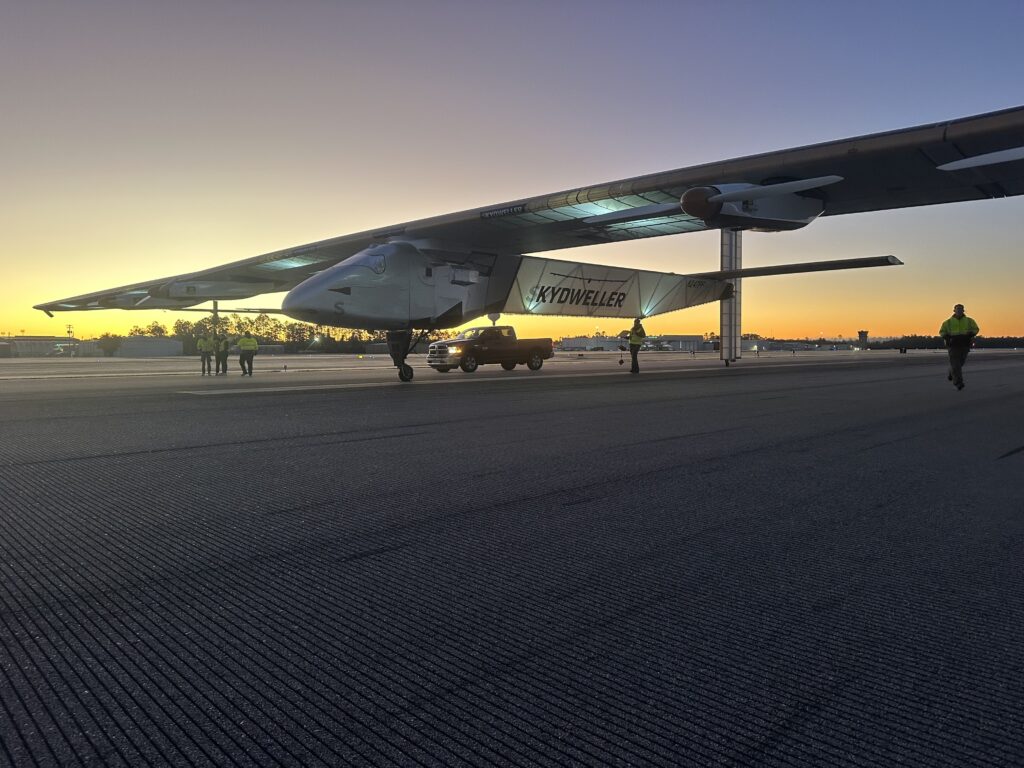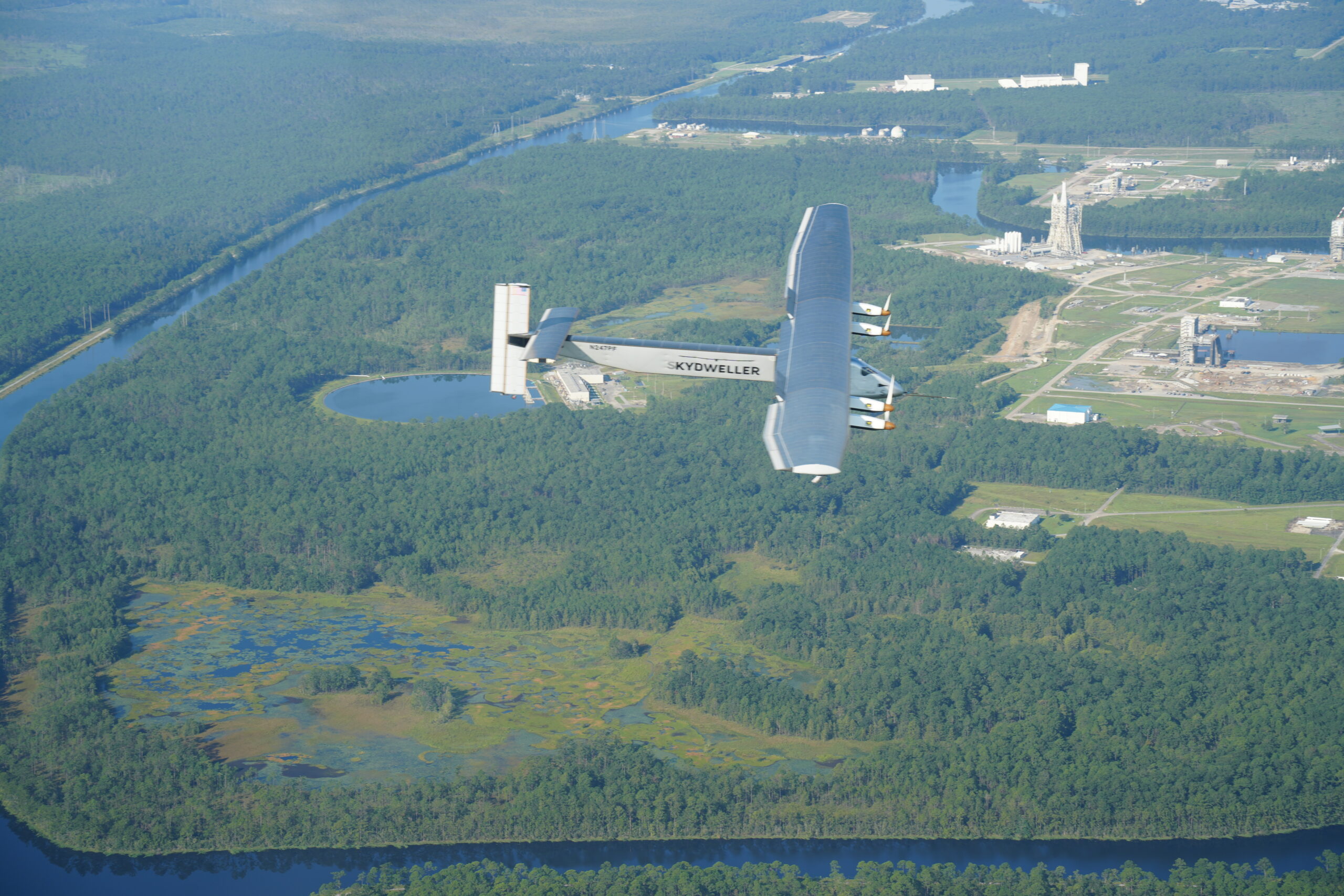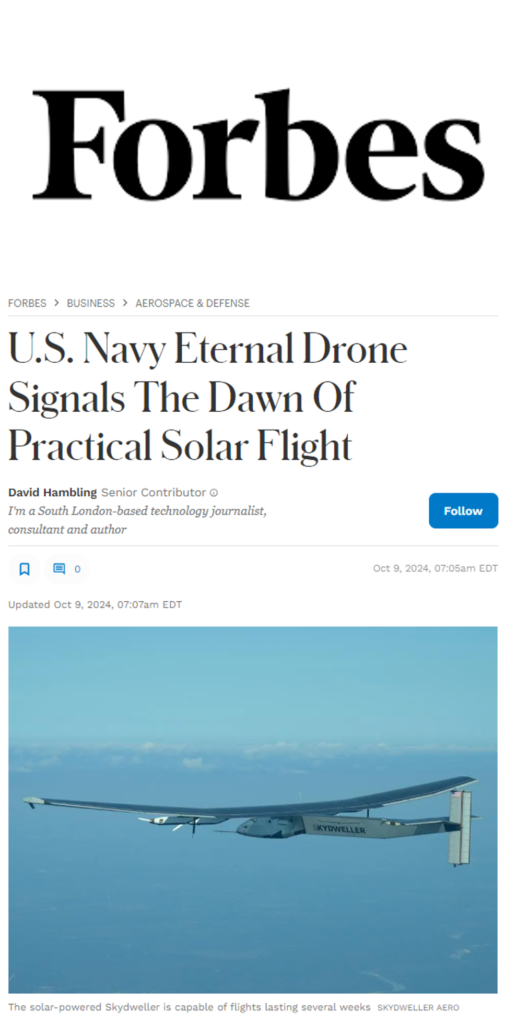
Oklahoma Firm Working Toward ‘Perpetual Flight’ – AVweb
Skydweller Aero advances autonomous solar aircraft testing for operational deployment in 2025
Skydweller Aero advances autonomous maritime patrol aircraft testing with military payloads
Skydweller Aero continues AMPA flight tests with operational military payloads | CompositesWorld
Skydweller Aero continues flight tests with operational military payloads – Air Cargo Week
Skydweller Aero continues Autonomous Maritime Patrol Aircraft (AMPA) Flight Tests – Naval News
Skydweller Aero Continues AMPA Flight Tests with Operatioanl Military Payloads
Skydweller continues tests – IOT Insider
Skydweller Aero advances flight tests for its Autonomous Maritime Patrol Aircraft – Defense Here
Solar aircraft soars with groundbreaking 22-hour autonomous flight mission. | USA Solar Cell
NASA Stennis to support unmanned aircraft testing – Machinery Market News
MS Stennis Space Center tests uncrewed aircraft
NASA Stennis expands range operations with new Skydweller Aero agreement
NASA Stennis Takes Key Step in Expanding its Range Operations Work – WXXV News 25
NASA Stennis Expands Range Operations Efforts | Mirage News
Skydweller Aero allowed use of NASA Stennis Space Center restricted airspace – Magnolia Tribune
NASA Stennis takes key step in expanding its range operations work | News | seacoastecho.com
U.S. Navy Eternal Drone Signals The Dawn Of Practical Solar Flight (forbes.com)
Solar-powered plane off Gulf Coast could spend months in air | Business News | nola.com
Skydweller Completes Autonomous Solar-Powered Flight Tests | RealClearDefense
Aviation Week features Skydweller Aero – “Solar-Powered UAS Completes 22.5 hour Flight” – Skydweller
SkyDweller Aero completes tests of ultra-long-endurance solar aircraft | News | Flight Global
Skydweller Aero Completes Successful Uncrewed Solar Flight Tests (botsanddrones.uk)
Skydweller Aero Successfully Completes “First Uncrewed Flight Test Campaign” – eVTOL Insights
Skydweller Aero: The 90-Day Solar Flight Revolution (aircomment.info)
World Military News: Skydweller Completes Autonomous Solar Powered Flight Tests
First flight: Solar-powered Skydweller — General Aviation News
Game-Changer: Solar-Powered Skydweller Drone Flies for 22.5 Hours in Breakthrough Test (msn.com)
Skydweller successfully concludes series of autonomous flights – IOT Insider
Skydweller Aero completes initial uncrewed flight test campaign – SatNews
Skydweller Aero successfully completes initial uncrewed flight test campaign – Air Cargo Week
Skydweller Aero completes autonomous flight test campaign | CompositesWorld
Skydweller Aero Completes Uncrewed Flight Testing | Aero-News Network
Skydweller completes initial flight test campaign | Revolution.aero
Skydweller Aero Successfully Completes Uncrewed Flight Test Campaign | UAS Magazine
Solar-Powered ‘Skydweller’ Drone Flies 22.5 Hours in Test (thedefensepost.com)
Skydweller’s solar UAS aces test flight campaign, hitting milestones. | USA Solar Cell
Skydweller Autonomous Solar Flight Test Completed (defencetrend.com)
News :: Airplanes :: Skydweller completes initial flight test campaign (avfoil.com)
Skydweller Aero Triumphs with Record-Setting Uncrewed Aerial Tests – UASweekly.com
Skydweller’s solar-powered UAS completes test flight campaign (aerospaceglobalnews.com)
US tests Skydweller drone with solar panels (gagadget.com)
Skydweller drone completes first uncrewed flight test campaign | Aerospace Testing International
Skydweller completes autonomous solar-powered flight tests (defence-blog.com)
Skydweller Aero Successfully Completes Uncrewed Flight Test Campaign | UAS Magazine
Skydweller Aero Successfully Completes Initial Uncrewed Flig (asdnews.com)
Solar-power drone completes flight test for U.S. military – Military Embedded Systems
U.S. has tested an eternal drone: What you need to know | News.az
A solar-powered plane flies continuously for more than 20 hours: this is Skydweller

OKLAHOMA CITY | 16 December 2024 – Skydweller Aero Inc., a global leader in Perpetual Flight® uncrewed solar aircraft (USA), continues its Autonomous Maritime Patrol Aircraft (AMPA) flight tests of the Skydweller unmanned aerial system (UAS) with operational military payloads integrated onboard.
“Skydweller is equipped with a variety of sensor systems and is conducting flight tests out of Stennis International Airport in preparation for operations during 2025,” said Dr. Robert Miller, CEO and Co-founder of Skydweller Aero. “The resilience and robust design of our aircraft allow us to operate a multi-INT sensor suite of payloads throughout the winter, and we expect to conduct multi-day demonstrations in early 2025 over operationally relevant areas.”
These flights build upon Skydweller Aero’s successful autonomous flight trials conducted in late summer and fall 2024. Despite the challenging Gulf Coast weather—including two hurricanes—the company completed six flights between August 22 and September 22, four of which were fully autonomous. The longest missions lasted 16 and 22.5 hours respectively, demonstrating the aircraft’s operational effectiveness over land and offshore environments, as well as at altitudes of up to 33,000 feet.
“The aircraft maintained an impressive operational tempo, flying on average one mission every five days,” Dr. Miller added. “This performance showcases the reliability and ease of maintenance of our platform.”
Operating amid peak Atlantic hurricane season, Skydweller’s Flight Operations, Weather Scientists, and Ground Support teams worked together to fine-tune the aircraft’s autonomous capabilities, ensuring a rapid response to shifting weather conditions.
“Flying in close proximity to Mississippi thunderstorms allowed us to test and enhance our weather-avoidance systems. Skydweller’s ability to navigate these conditions highlights its operational value, especially in tropical regions during hurricane and typhoon seasons.” explained Dr. Miller. “This ability to navigate around dynamic weather patterns is vital for missions that require flight in challenging environments; avoiding sudden thunderstorms is similar to evading air defenses.”
“And unlike many other uncrewed aircraft, we are not limited to clear-sky operations in controlled environments, like the Arizona or New Mexico deserts, but will operate in operationally relevant theaters,” he added.
The Skydweller is distinguished by its durable design, exceptional payload capacity and substantial power output for mission-critical systems, offering kilowatts of continuous power for payloads. This unique combination enables Skydweller to undertake extreme duration missions across diverse and challenging environmental conditions.
“Skydweller’s capabilities have been consistently validated through rigorous flight testing, achieving significant milestones without any safety incidents,” said Barry Matsumori, President & COO of Skydweller Aero. “By leveraging our team’s deep expertise in aeroelastics, flight control systems, mission systems, and autonomy, we are developing what we believe to be the world’s first operationally viable perpetual flight platform—designed to serve the needs of both government and commercial markets.”
About Skydweller Aero Inc.
Skydweller Aero Inc. is a pioneering transatlantic aerospace company developing a fleet of the world’s largest solar powered uncrewed aircraft capable of performing extreme endurance flights with heavy, powerful payloads. Skydweller autonomous all carbon fiber aircraft have a wingspan greater than a 747 and weigh about the same as a Ford F-150. Skydweller’s uncrewed aircraft will be used for ultra-long duration missions such as providing exclusive economic zone (EEZ) enforcement, monitoring naval activity, and detecting drug smugglers and pirates at sea. Skydwellers accomplish these missions with zero carbon footprint. Skydweller Aero Inc., backed by venture and private capital, has World and US headquarters in Oklahoma City and European offices headquartered in Spain. http://www.skydweller.aero
FOX’s CyberGuy Features Skydweller Aero
Solar-powered aircraft achieves groundbreaking 22-hour autonomous flight
How perpetual flights could soon be reality
Imagine an aircraft that can stay airborne for weeks, even months, without refueling. This isn’t futuristic fantasy.
Skydweller Aero is working toward turning this vision into reality with its innovative solar-powered plane.
As the world’s largest unmanned solar-powered aircraft, Skydweller is pushing the boundaries of what’s possible in aviation.
The Skydweller advantage
What sets Skydweller apart from its predecessors? Its foundation is built on the Solar Impulse, the first solar-powered aircraft to circumnavigate the globe. This heritage provides Skydweller with a robust design capable of carrying substantial payloads. With a wingspan of 236 feet (larger than a 747) and weighing just 5,620 pounds (about the same weight as a Ford F150), the Skydweller can carry up to 800 pounds of payload.
A milestone achievement
Skydweller Aero recently achieved a significant milestone by completing a series of uncrewed autonomous flight tests. The longest of these flights lasted an impressive 22½ hours, launched from the company’s facility at Stennis International Airport in Kiln, Mississippi. This achievement demonstrates the feasibility of remaining airborne for extended periods using solar energy and batteries.
Kurt’s key takeaways
As the world’s largest unmanned solar aircraft, Skydweller Aero is revolutionizing aviation and opening up exciting new possibilities. From enhancing maritime patrols to serving as airborne communication platforms, the potential applications are vast.
Watch / read FOX’s CyberGuy Feature Skydweller Aero:
Link to video – https://www.foxnews.com/video/6364663907112
Link to article – Solar-powered aircraft achieves groundbreaking 22-hour autonomous flight | Fox News Video

Skydweller Aero Can Help Defend Against Chinese Fishing Fleet Encroachments
The Wall Street Journal has revealed how Chinese fishing fleets are impacting the fishing industry of Peru and other vulnerable countries globally, threatening both local communities and national economies.
For developing nations, maritime domain awareness is vital for protecting sovereignty, sustaining economies, and supporting long-term environmental health.
Effective surveillance and response capabilities are crucial in guarding against overfishing and illegal activities within under-regulated exclusive economic zones.
Skydweller Aero is committed to advancing persistent surveillance solutions that enhance real-time situational awareness across vast maritime territories. For enforcement to be effective, agencies need photos of fishing boats with nets in the water, and the ability to identify those vessels.
Agencies need Skydweller.
Our innovations in solar-powered, autonomous aircraft empower countries to protect their resources and secure their maritime interests.
China’s Massive Fishing Fleet Overwhelms Locals in ‘David and Goliath’ Battle – WSJ

Skydweller Aero Incorporated has come to an agreement with NASA Stennis Space Center to use restricted airspace for test flights.
“It was a challenge because they had a lot of different scenarios based on their requirements,” said Jason Peterson, Range Operations Manager at NASA Stennis Space Center. “They pushed the envelope so to speak, but we were able to overcome that with our team.”
With this access, Skydweller will be able to perform test flights in a controlled airspace with limited obstacles, allowing for less hiccups as they work on developments.
“This is developing technology that’s going to connect the unconnected from a digital perspective, and make the world a safer, more connected place,” said Robert Miller, CEO of Skydweller.
The aircraft Skydweller flies is different from your typical plane. This plane is manned by a remote pilot and powered by solar power, allowing for less carbon emissions and extended flight times.
“Conventional unmanned aircrafts fly for 40-80 hours tops,‘ said Miller. ”We’re talking about flying for weeks, months, so hundreds and thousands of hours we’d be in the air.”
With this agreement, the expected speed for findings should increase greatly, allowing for the newest breakthroughs in aviation technology to be found here in South Mississippi.
“This is technology that people in Silicon Valley failed at that were succeeding in in Mississippi and Oklahoma,” said Miller.
Aviation agreement to bring new tech breakthroughs to the Gulf Coast

NASA’s Stennis Space Center and Skydweller Aero enter agreement for company to operate its solar-powered autonomous aircraft in the site’s restricted airspace, a key step towards Stennis achieving a strategic goal.
NASA’s Stennis Space Center near Bay St. Louis, Mississippi, has entered into an agreement with Skydweller Aero Inc. for the company to operate its solar-powered autonomous aircraft in the site’s restricted airspace, a key step towards achieving a strategic center goal.
The Reimbursable Space Act agreement marks the first between NASA Stennis and a commercial company to utilize the south Mississippi center’s unique capabilities to support testing and operation of uncrewed systems.
“There are few locations like NASA Stennis that offer a secure location, restricted airspace and the infrastructure to support testing and operation of various uncrewed systems,” said NASA Stennis Director John Bailey. “Range operations is a critical area of focus as we adapt to the changing aerospace and technology landscape to grow into the future.”
NASA Stennis and Skydweller Aero finalized the agreement in late August, paving the way for the company to begin area test flights of its autonomous, uncrewed solar-powered aircraft, which features a wingspan greater than a 747 jetliner and is designed for long-duration flights.
“Access to the restricted airspace above NASA Stennis has been tremendously helpful to our uncrewed, autonomous flight operations,” said Barry Matsumori, president and chief operating officer of Skydweller Aero. “The opportunity to use the controlled environment above Stennis helps accelerate our efforts, allowing us to transition the aircraft in and out of civil airspace, while demonstrating its reliability and unblemished safety record to the FAA.”
The agreement provides the company Federal Aviation Administration (FAA) authorization for future test flights in designated areas of the NASA Stennis buffer zone. It also represents a key step in the center’s effort to grow its range operations presence.
NASA Stennis Takes Key Step in Expanding its Range Operations Work – NASA
Skydweller over NASA Stennis Space Center

A Skydweller solar-powered drone just successfully completed a series of test flights with U.S. Navy funding. This time the longest flight was ‘just’ 22.5 hours, but in operation the aircraft will fly patrol missions lasting for weeks, powered by solar cells in the day and batteries at night.
The road to solar aircraft with effectively unlimited endurance has been a long one, littered with the flimsy fragments of failed projects. The Navy is finally closing in on an important new capability, one that could transform its long-range, long-endurance missions – and kickstart a whole new field of commercial aviation.
Made of lightweight carbon fiber, Skydweller has a wingspan of 236 feet (72 meters) but weighs just 5,620 pounds (2,550 kilograms), less than many light aircraft, with up to 800 pounds of payload. Robust, flexible wings are essential.
“In this field you need to really understand what it means to fly large flexible structures,” Skydweller Aero CEO Robert Miller told me. “If the people who are developing it do not understand aeroelasticity you can get wings popping off.”
Skydweller is strong and flexible enough to survive where others have literally disintegrated.
In principle building a perpetual solar aircraft is easy. Just find a lightweight powered glider, cover the wings with solar cells and add electric motors and batteries. In practice it is far from simple. The big, fragile aircraft are prone to break apart when hit by turbulence or other stresses encountered while getting to and from the stratosphere, a challenge has defeated some of the best in the business.
“There is ‘death zone’ for these aircraft from five to thirty thousand feet,” says Miller, and aircraft behave in complex ways. “Aerodynamics scale, but aeroelastics don’t.”
NASA failed. Its groundbreaking solar-powered HELIOS prototype flew to over 90,000 feet in 2001, but broke up in midair in 2007, and the project was terminated.
Boeing and DARPA failed. After Boeing won an $89m contract for their Solar Eagle aircraftfrom DARPA, they ran into difficulties and the program ended in 2012, with DARPA abandoning flight tests in favor of basic research into energy management.
Google failed. Their Solara 50 was supposed to provide internet connectivity to remote areas, but during flight tests crashed shortly after takeoff in 2015. The aircraft suddenly gained speed and “the left outboard wing section separated from the aircraft” according to an NTSB report. Google gave up with the project shortly afterwards.
Facebook failed. Their Aquila was another project intended to provide internet from the skies, but a prototype a broke up in mid-air in 2016. While Aquila was coming into land, a sudden gust of wind caused the right wing to break off. The Aquila program did not recover and was canceled in 2018.
Skydweller Aero started with two big advantages over the others. One is that it is derived from the Solar Impulse crewed aircraft which flew around the world in 2016. While other solar aircraft only carry a few pounds, Solar Impulse had a crew capsule weighing several hundred pounds, meaning it was built with safety in mind and had plenty of capacity when it was converted to uncrewed operation. The other advantage is the level of expertise.
“Fundamentally, my team has a lot more experience in aeroelasticity than all the other solar programs combined,” says Miller. “ Sometimes they don’t know what they don’t know. My team has worked on aircraft that have a million plus hours in the stratosphere.”
This expertise has produced a robust, reliable aircraft suitable for military service.
Solar Flight Plan
Miller says that the recent flight tests collected all the data they needed to validate the result of simulations. The campaign was sustained by funding from Naval Air Warfare Center Aircraft Division (NAWCAD) to evaluate autonomous maritime patrol aircraft.
The next stage will involve flying with the sensors and communications that the aircraft will use in operation with the Navy.
“In the winter we’ll be flying short flights of 15 to 20 hours in the Gulf of Mexico and the Caribbean with full U.S. Navy payloads, to demonstrate the utility of the system and how we can collect and distribute data,” says Miller. “In the Spring we will be flying 7-to-15-day flights, which is when our objective will be fully achieved.”
Skydweller Aero gives the Navy an aircraft with unprecedented endurance. Their current long-range drone is the MQ-4C Triton, a conventionally-fueled aircraft with an endurance of 30 hours. But this type of aircraft is expensive buy and expensive to fly, costing an estimated $35,000 per flight hour to operate — or a million dollars for a 30-hour mission. The Skydweller is far cheaper, with no fuel requirement and very little maintenance — “It’s flight hours per maintenance hour, rather than maintenance hours per flight hour,” says Miller.
Even with recent upgrades, Skydweller Aero is not pushing the limits of what is technologically possible for this type of aircraft.
“The fly-by-wire control system has been upgraded and it is now fully redundant with no single point of failure. The batteries have been upgraded to the state-of-the art of what is now in production,” says Miller. “We will shortly be upgrading the engines with high efficiency motors that have magnetic gearboxes, that will bring ultra-reliability and about an 8-10% increase in efficiency.”
Solar aircraft benefit from being at the intersection of several technologies, all of which are improving.
“There has been a lot of growth in the technology in general, “says Miller. “With massive industry investment in solar, in batteries and in motors. The water is rising and all the boats are rising with it.”
That rise could enable a whole new solar-powered aviation industry.
Commercial Future
Skydweller will initially be a military project, carrying a variety of Navy sensors (typically radar) and communication packages. As we previously noted, a suite of AI software from Palantir will handle, fuse and analyze complex data collected by the sensors. Rather than beaming back gigabytes of video of empty ocean, Skydweller only needs to communicate when it sees a ship or other item of interest
But as Google and Facebook had observed, long-endurance solar aircraft also have tremendous commercial potential as airborne communications platforms.
“The military will be early adopters of this technology, and we can grind out the rough edges with them before we roll out to a wider base,” says Miller. “It is very much like satellite communications, where the military were early adopters. They burned down the risk and the market took off, now it is 99% commercial.”
Miller sees solar aircraft as a complementary capability to LEO satellite communications rather than a direct rival. In certain parts of the world — Miller mentions specific regions his team have looked at — the economics could favor a network of solar aircraft circling overhead to provide continuous coverage.
At present Skydweller Aero just have one aircraft but demand is likely to drive production.
“We hope to start building another aircraft next year, and then several more after that,” says Miller.
After that, production could accelerate rapidly into big numbers. Lightweight aircraft with no jet engines can be manufactured quicker than airliners or other aircraft.
There is a commercial rival in the form of the Zephyr series made by Airbus, a type which has been under development for more than 20 years. This is a smaller, lighter aircraft; the Zephyr 8 has an 82-foot wingspan and carries a payload of about 11 pounds compared to 800 pounds for Skydweller. Zephyr is marketed as a potential “flying cellphone tower” but the project has experienced difficulties. Three aircraft have been lost, the latest in an accident in June 2022 when, like so many others, it broke up in mid-air.
In solar aviation, only the strong survive. And Skydweller, originally built to be robust enough to carry human pilots safely, looks like the strongest drone in the field. After decades of dead ends, solar aviation may finally be taking off.
U.S. Navy Eternal Drone Signals The Dawn Of Practical Solar Flight (forbes.com)

Share the joy and triumph of our recently completed flight test campaign by watching this Skydweller Aero video, available here
Social Media Influencer “Papa Mississippi” is a proud Mississippian.
He is so happy that Skydweller Aero flies from Stennis International Airport in Kiln that he made this video.
Enjoy!

The Oklahoma-headquartered firm on 30 September said the Skydweller UAS successfully conducted a series of autonomous long-duration flights in recent weeks, including one sortie lasting 22h 30min and another spanning 16h.
SkyDweller Aero completes tests of ultra-long-endurance solar aircraft | News | Flight Global
